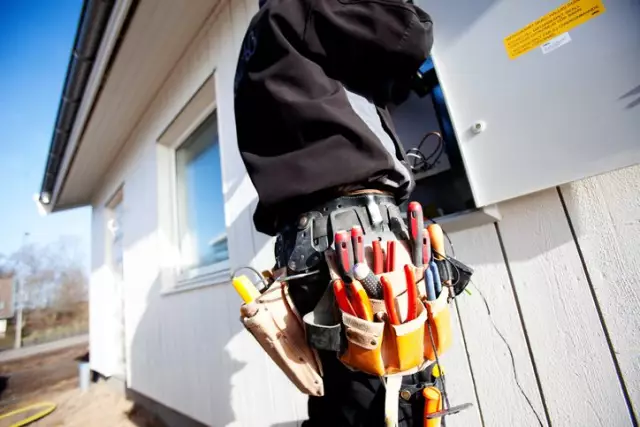- Author Rachel Wainwright [email protected].
- Public 2023-12-15 07:39.
- Last modified 2025-11-02 20:14.
Electrical trauma

An electrical injury is an injury resulting from an electric shock or lightning strike.
Dangerous to humans and leading to electrical injury are considered to be a current exceeding 0.15 Ampere, as well as alternating and direct voltages above 36 Volts. The consequences of an electrical injury can be very different: an electric shock can cause cardiac arrest, blood circulation, breathing, and loss of consciousness. Almost always, electrical trauma is accompanied by damage to the skin, mucous membranes and bones at the site of entry and exit of the electric discharge, leading to disruption of the activity of the central and peripheral nervous system.
Types of electrical injuries
Electrical injuries are classified according to the place of their occurrence, the nature of the effect of electrical voltage, the nature of the injury (local and general electrical injuries).
Depending on the place of receipt, such types of electrical injuries are distinguished: industrial, natural and domestic.
By the nature of the effect of electric current, electrical trauma can be instantaneous and chronic. Instant electric shock is a person receiving an electrical discharge that exceeds the permissible level in a very short period of time. It is such an electrical injury that is accompanied by serious injuries that require resuscitation and surgical intervention. And this type of electrical injury, as chronic, arises from the prolonged and imperceptible effect of electrical voltage on a person. An example is working near high power generators. People who undergo this type of electrical trauma have increased fatigue, sleep and memory disturbances, headaches, tremors, high blood pressure, and dilated pupils.
In addition, it is customary to distinguish such types of electrical trauma as local and general. Local electrical injury is a burn, electrophthalmia, metallization of the skin (contact with the skin and melting of small metal particles under the action of an electric arc), mechanical damage. And general electrical injuries occur when electrical shock to various muscle groups, which is manifested by convulsions, cardiac arrest, breathing
Causes of electrical injuries
The causes of electrical injuries in most cases (80-90 percent) is direct contact with current-carrying elements of electrical installations, work with them without first removing the voltage. The main causes of electrical injuries are negligence and inattention - incorrect supply of voltage and disconnection of the current source, unsatisfactory condition of insulation.
In other words, the causes of electrical injuries can be systematized as follows: technical reasons (equipment malfunction, improper operation), organizational (failure to comply with safety rules), as well as psychophysiological (fatigue, reduced attention).
It was noticed that in production a huge percentage of electrical injuries occur at the end and beginning of work shifts (shift shift), as well as in the morning (first) shift. In the first case, the factor of fatigue plays an important role, and in the second, the peculiarity of planning the working day: the maximum number of work with electrical installations falls on the morning hours.
Help with electrical injury

Regardless of the type of electrical injury (only if it is not natural, as a result of a lightning strike), first of all, when providing assistance to the victim, you should de-energize the source of injury in any way possible: press the switch on the device, turn the switch, unscrew the plugs or cut off the electrical wires.
When providing assistance in case of electrical injury, one must not forget about the precautions: it is possible to remove the wires from the victim only with the use of insulated tools, or with the help of any other, but dry object, be sure to wear rubber gloves. Also, without protecting your hands, you can not touch a person injured by electric shock unless the wires are disconnected.
A person who has received a general or local electrical injury should be placed on a flat surface, be sure to call an ambulance and take the following actions:
1. Check the pulse, and if it is absent (circulatory arrest), perform an indirect heart massage;
2. Check respiration, and if not, administer artificial respiration;
3. If there is a pulse and breathing, you should put the victim on his stomach and at the same time turn his head to one side. So a person will be able to breathe freely and not choke on vomit;
4. A bandage should be applied to burns caused by electrical injury, be sure to dry and clean. If your feet or hands are burned, you should put rolled bandages or cotton swabs between your fingers;
5. Inspect the victim for other related injuries and, if necessary, provide assistance;
6. If a person is conscious, it is recommended to give him / her large quantities of liquid to drink;
When providing assistance in case of an electrical injury, it is impossible to leave the injured person alone, and it is imperative to organize his transportation to a medical institution, where he will be examined and professional assistance will be provided. This must be done, even if outwardly the lesions seem insignificant: the patient's position can change at any time.
YouTube video related to the article:
The information is generalized and provided for informational purposes only. At the first sign of illness, see your doctor. Self-medication is hazardous to health!






